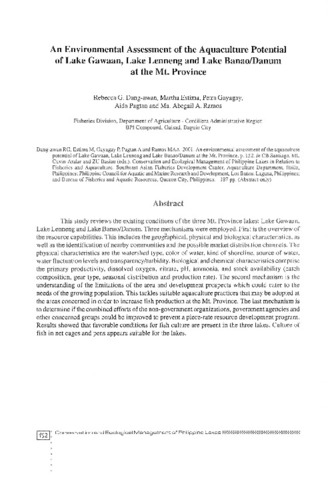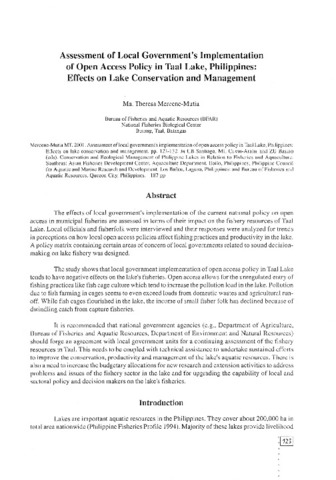Net mesh size affects production of giant freshwater prawn Macrobrachium rosenbergii cultured in lake-based cages
- Global styles
- MLA
- Vancouver
- Elsevier - Harvard
- APA
- Help
Share
抄録
Cage culture of freshwater prawns in open waters is prone to the entry of predators and competitors that particularly hamper production. This study was conducted to determine how smaller net mesh sizes to reduce entry of unwanted species inside the cages affects the production of Macrobrachium rosenbergii in lake-based cages. Juvenile prawns were stocked in cages (7 × 7 × 1.5 m) of two net mesh sizes at 10 individuals m-2 and cultured for 10 months in a shallow eutrophic lake in the Philippines. The two net mesh sizes were either 5 mm-mesh B-nets or and 1 mm-mesh Hapa nets. Each treatment had four replicates each and was fed based on biomass with commercially formulated feed. Monitoring of various production parameters was done during the two phases of culture: batch phase on days 63 and 127 and the selective harvest phase on days 187, 219, 253, 281 and 313, when the experiment was terminated. For the first 127 days of culture, the weight, percent weight increase, daily growth rate (DGR), specific growth rate (SGR), yield and feed conversion ratio (FCR) were significantly better in prawns reared in the Hapa compared to the B-nets. During the selective harvest phase the blue claw, orange claw and berried females were selectively harvested and the remaining prawns returned to the cages. After changes in stocking density through culling, ancova was used to compare the effect of mesh size with the total number of prawns returned to the cages as a covariate. Yield was significantly higher in the Hapa nets. Weight, DGR, SGR and FCR were also consistently higher in the Hapa nets, although not always significantly different. The overall better performance of prawns reared in the Hapa net cages was due to: (i) the reduction in the entry of predator and competitor species in the finer-meshed Hapa compared to the larger mesh B-net, (ii) more natural food trapped inside the Hapa cages, and (iii) a higher number of selectively harvested prawns, which decreased stocking density in the cages and improved growth. Use of small mesh size nets is recommended in the cage culture of M. rosenbergii in inland natural water bodies.
Suggested Citation
Cuvin-Aralar, M. L. A., Lazartigue, A. G., & Aralar, E. V. (2013). Net mesh size affects production of giant freshwater prawn Macrobrachium rosenbergii cultured in lake-based cages. Journal of Applied Ichthyology , 29(4), 833-838. https://doi.org/10.1111/jai.12189
Type
ArticleISSN
0175-8659; 1439-0426Collections
- Journal Articles [1258]
Related items
Showing items related by title, author, creator and subject.
-
An environmental assessment of the aquaculture potential of Lake Gawaan, Lake Lenneng and Lake Banao/Danum at the Mt. Province
Dang-awan, Rebecca G.; Estima, Martha; Gayagay, Petra; Pagtan, Aida; Ramos, Ma. Abegail A. (Aquaculture Department, Southeast Asian Fisheries Development Center; Philippine Council for Aquatic and Marine Research and Development (PCAMRD), Department of Science and Technology; Bureau of Fisheries and Aquatic Resources, 2001)This study reviews the existing conditions of the three Mt. Province lakes: Lake Gawaan, Lake Lenneng and Lake Banao/Danum. Three mechanisms were employed. First is the overview of the resource capabilities. This includes ... -
Assessment of local government's implementation of open access policy in Taal Lake, Philippines: Effects on lake conservation and management
Mercene-Mutia, Ma. Theresa (Aquaculture Department, Southeast Asian Fisheries Development Center; Philippine Council for Aquatic and Marine Research and Development (PCAMRD), Department of Science and Technology; Bureau of Fisheries and Aquatic Resources, 2001)The effects of local government's implementation of the current national policy on open access in municipal fisheries are assessed in terms of their impact on the fishery resources of Taal Lake. Local officials and fisherfolk ... -
Culture of Macrobrachium rosenbergii (De Man 1879) in experimental cages in a freshwater eutrophic lake at different stocking densities
Cuvin-Aralar, Maria Lourdes; Aralar, Emiliano V.; Laron, Manuel A.; Rosario, Westley (Blackwell Publishing, 2007)Macrobrachium rosenbergii (de Man 1879) juveniles (0.4 g) were cultured in experimental cages (L × W × H: 2.5 × 1 × 1 m) in Laguna de Bay, the largest lake in the Philippines. The following stocking densities at four ...





